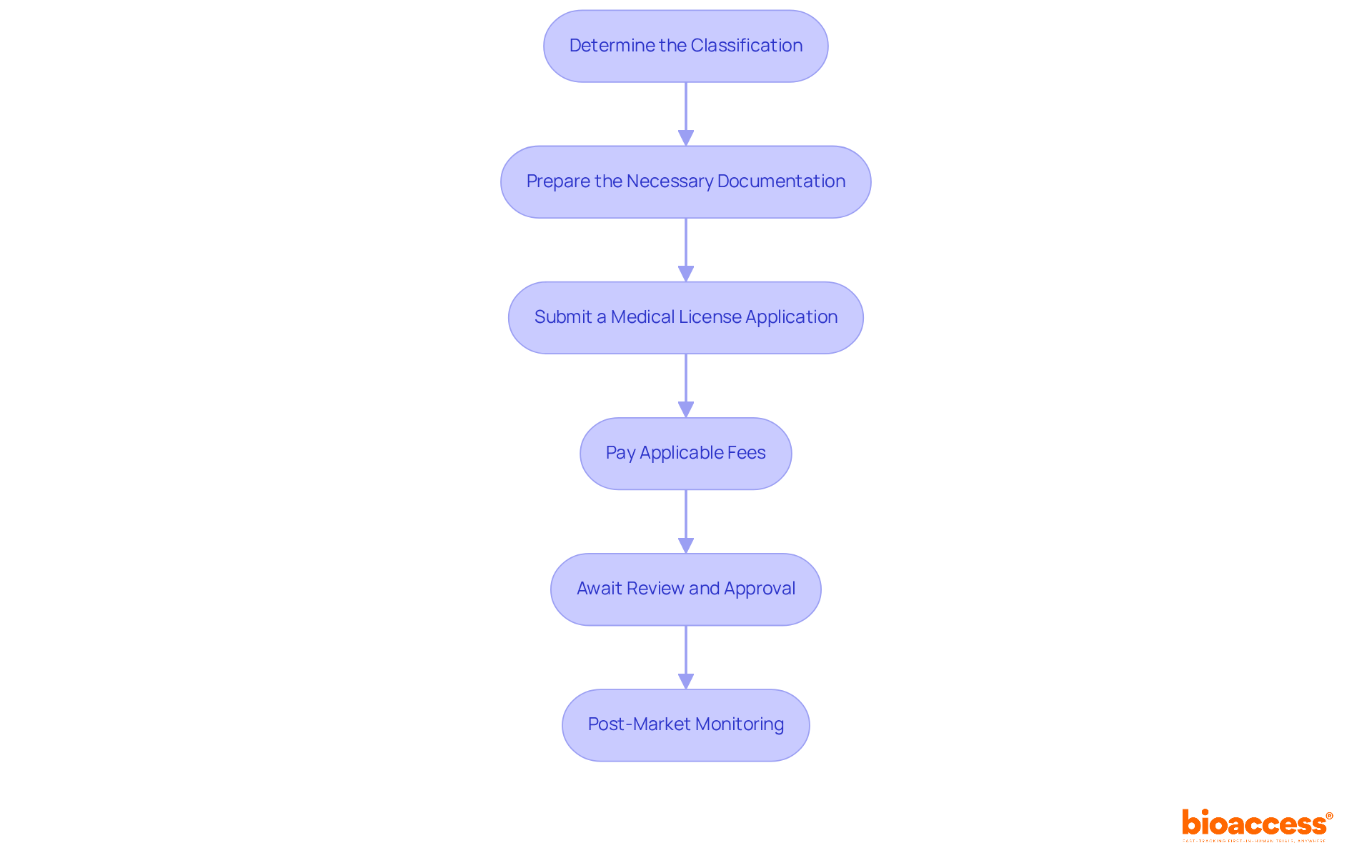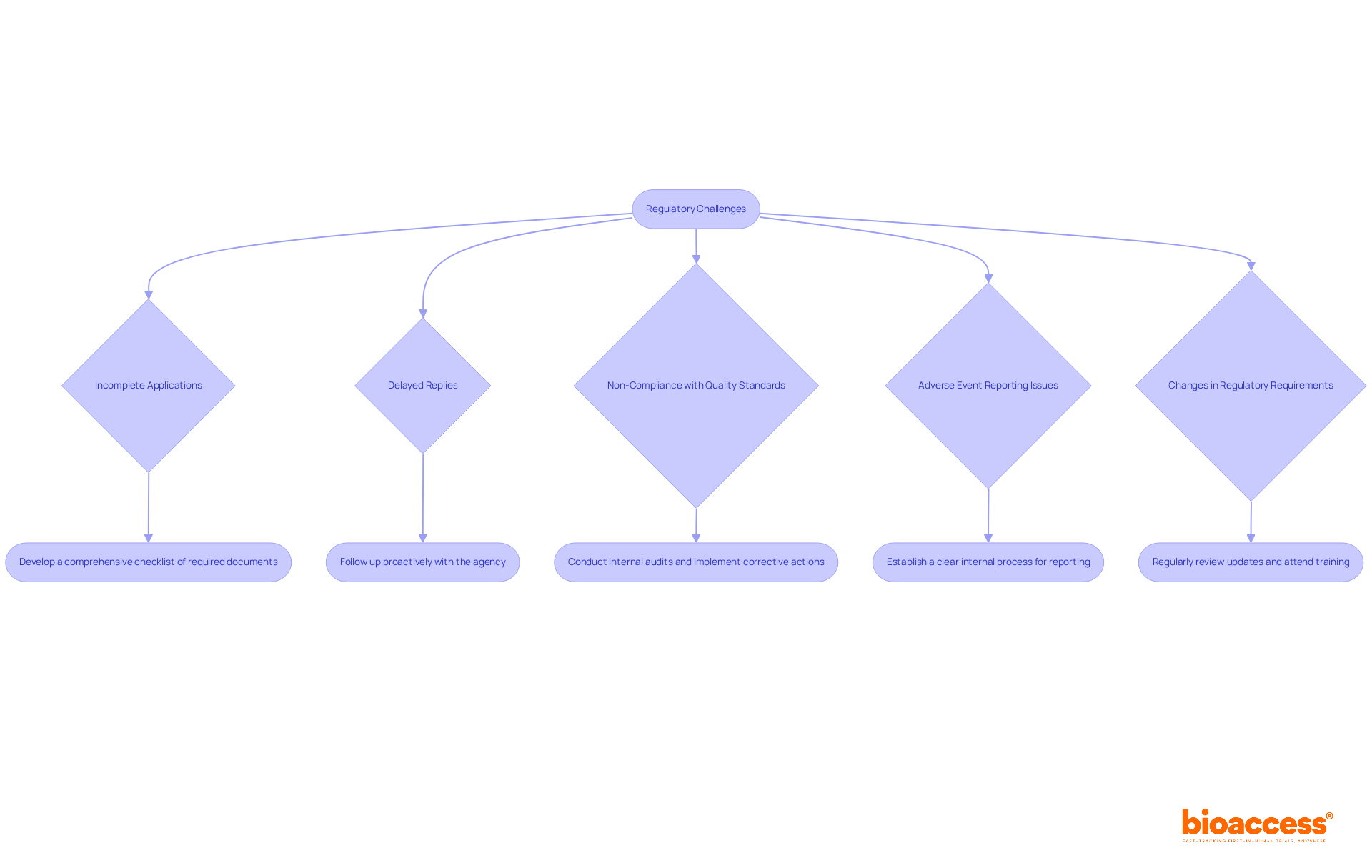


Navigating Canada’s medical device regulations necessitates a comprehensive understanding of the regulatory framework established by Health Canada. This framework categorizes devices into four classes based on their risk levels, each accompanied by specific compliance requirements.
To ensure adherence to safety and effectiveness standards, it is crucial to follow essential steps for compliance. These steps include:
Navigating the complex landscape of medical device regulations in Canada presents significant challenges for manufacturers and innovators. Health Canada’s framework categorizes devices into risk-based classes, making it essential to grasp these regulations not merely as legal obligations but as vital components for ensuring product safety and achieving market success.
What occurs, however, when the compliance process is fraught with difficulties, ranging from incomplete applications to shifting regulatory standards? This guide provides a clear roadmap for overcoming these hurdles, equipping stakeholders with the necessary knowledge to adeptly navigate the intricacies of Canadian medical device regulations.
To navigate the Canada medical device regulations effectively, it is essential to grasp the regulatory framework established by Health Canada. This framework encompasses the Medical Devices Regulations (SOR/98-282), which categorize medical devices into four classes based on their risk levels:
Each class entails specific requirements for licensing and compliance. Familiarize yourself with the relevant guidance documents provided by the government agency, as these are instrumental in understanding the Canada medical device regulations. These documents can be found on the official government health website, which outlines the necessary steps for compliance and application procedures. Understanding these classifications and their implications is the crucial first step in ensuring that your product meets regulatory standards before entering the market.

To comply with Health Canada's regulations, it is essential to follow these steps, guided by the expertise of leaders in regulatory affairs such as Ana Criado, Director of Regulatory Affairs and CEO of Mahu Pharma:
Determine the Classification: Identify the category of your medical apparatus based on its intended use and risk level. This classification will dictate the regulatory pathway you must follow.
Prepare the Necessary Documentation: Depending on the classification, prepare the required documentation, including a device description, intended use, evidence of safety and effectiveness (clinical data, if applicable), and quality management system documentation (ISO 13485 certification may be required for higher classes).
Submit a Medical License Application: For Class II, III, and IV items, submit a Medical License (MDL) application to Health Canada. Ensure that all documentation is complete and accurate to avoid delays.
Pay Applicable Fees: Be aware of the tiered fee structure based on the equipment class. For instance, as of April 1, 2025, Class II medical equipment license applications incur a fee of CAD $632.
Await Review and Approval: Health authorities will examine your application to ensure adherence to safety, effectiveness, and quality standards. Be prepared to respond to any requests for additional information.
Post-Market Monitoring: After your product receives approval, uphold regulations through post-market monitoring, including reporting any negative incidents or product flaws.
By adhering to these steps, you can navigate the intricacies of Canada medical device regulations. Insights from experts like Ana Criado, whose vast experience in regulatory affairs and biomedical engineering can assist you throughout the conformity process, are invaluable.

Efficient management of documentation and reporting is crucial for adherence to Canada medical device regulations. It is essential to maintain comprehensive records, which include detailed documentation related to your medical device, such as:
This must be in compliance with Canada medical device regulations and correspondence with Health Canada.
Implementing a document control system is vital. This system should manage revisions and ensure that all team members have access to the most current documents. It must also track changes and maintain an audit trail, reinforcing accountability.
Adhering to reporting requirements is non-negotiable. Be aware of the obligations regarding adverse events and product defects. The Canadian health authority mandates that producers disclose any events that might impact the safety or efficacy of their devices, ensuring public trust and safety.
Conducting regular audits is another key practice. Frequently reviewing your documentation and reporting procedures guarantees adherence to the health authority's requirements. This proactive approach can help identify potential issues before they escalate into significant problems, safeguarding your operations.
Staying updated on Canada medical device regulations is essential. Regulations, such as Canada medical device regulations, can evolve, making it critical to remain informed about updates to Health Canada’s guidelines and requirements. Subscribing to relevant newsletters or joining industry associations will provide timely information, keeping you ahead in compliance.
Finally, consider leveraging comprehensive clinical trial management services. Utilizing Bioaccess's offerings, which encompass:
This can streamline your processes. This not only enhances compliance with regulatory standards but also ensures that all documentation is thorough and up-to-date.

Navigating the regulatory landscape presents significant challenges that demand attention. Common issues arise, and knowing how to troubleshoot them is crucial for success:
Incomplete Applications: A frequent challenge is the submission of incomplete applications. To mitigate this risk, develop a comprehensive checklist of all required documents, ensuring that each item is thoroughly addressed prior to submission.
Delayed Replies from the Agency: Encountering delays in responses from regulatory bodies can be frustrating. It is advisable to follow up proactively, inquiring about the status of your application. Clear communication is essential, and providing any additional information promptly can facilitate the process.
Non-Compliance with Quality Standards: Aligning your quality management system with ISO 13485 standards is imperative. Conducting internal audits to identify gaps and implementing corrective actions before application submission will strengthen your compliance posture.
Adverse Event Reporting Issues: Familiarity with the reporting guidelines provided by relevant authorities is essential when reporting adverse events. Establishing a clear internal process for documenting and reporting incidents will enhance your organization's responsiveness.
Changes in Regulatory Requirements: Staying informed about regulatory changes is vital. Regularly reviewing updates and guidance documents from Health Canada, as well as attending industry conferences and training sessions, will ensure your knowledge remains current.
By proactively addressing these challenges, you can streamline your compliance process and significantly enhance your chances of successfully navigating the Canada medical device regulations.

Navigating the intricate landscape of Canadian medical device regulations is crucial for ensuring product safety and compliance. A thorough understanding of the regulatory framework established by Health Canada—including device classification and necessary compliance steps—serves as the foundation for successful market entry. This guide underscores the importance of adhering to these regulations, safeguarding public health while facilitating the introduction of innovative medical technologies.
Key insights from this discussion highlight the necessity of:
By recognizing the significance of maintaining precise records and effectively managing reporting requirements, manufacturers can mitigate common challenges, such as incomplete applications and non-compliance with quality standards. A proactive approach to troubleshooting issues enhances the likelihood of a smooth regulatory process.
Ultimately, staying informed about evolving regulations and leveraging expert resources can significantly streamline compliance efforts. Engaging with industry associations and subscribing to relevant updates ensures that manufacturers remain ahead of the curve in meeting Health Canada's expectations. By prioritizing regulatory adherence, companies not only protect their products but also contribute to the overall safety and efficacy of medical devices in Canada.
What is the purpose of the Canadian medical device regulatory framework?
The purpose of the Canadian medical device regulatory framework is to establish guidelines and requirements for the licensing and compliance of medical devices to ensure safety and effectiveness.
What are the four classes of medical devices in Canada?
The four classes of medical devices in Canada are: Class I: Low risk (e.g., bandages), Class II: Moderate risk (e.g., infusion pumps), Class III: High risk (e.g., implantable devices), Class IV: Very high risk (e.g., pacemakers).
How are medical devices categorized in Canada?
Medical devices are categorized based on their risk levels, which determines the specific requirements for licensing and compliance associated with each class.
Where can I find guidance documents related to Canadian medical device regulations?
Guidance documents related to Canadian medical device regulations can be found on the official government health website, which outlines necessary steps for compliance and application procedures.
Why is it important to understand the classifications of medical devices?
Understanding the classifications of medical devices is crucial for ensuring that a product meets regulatory standards before entering the market, as each class has specific requirements that must be adhered to.